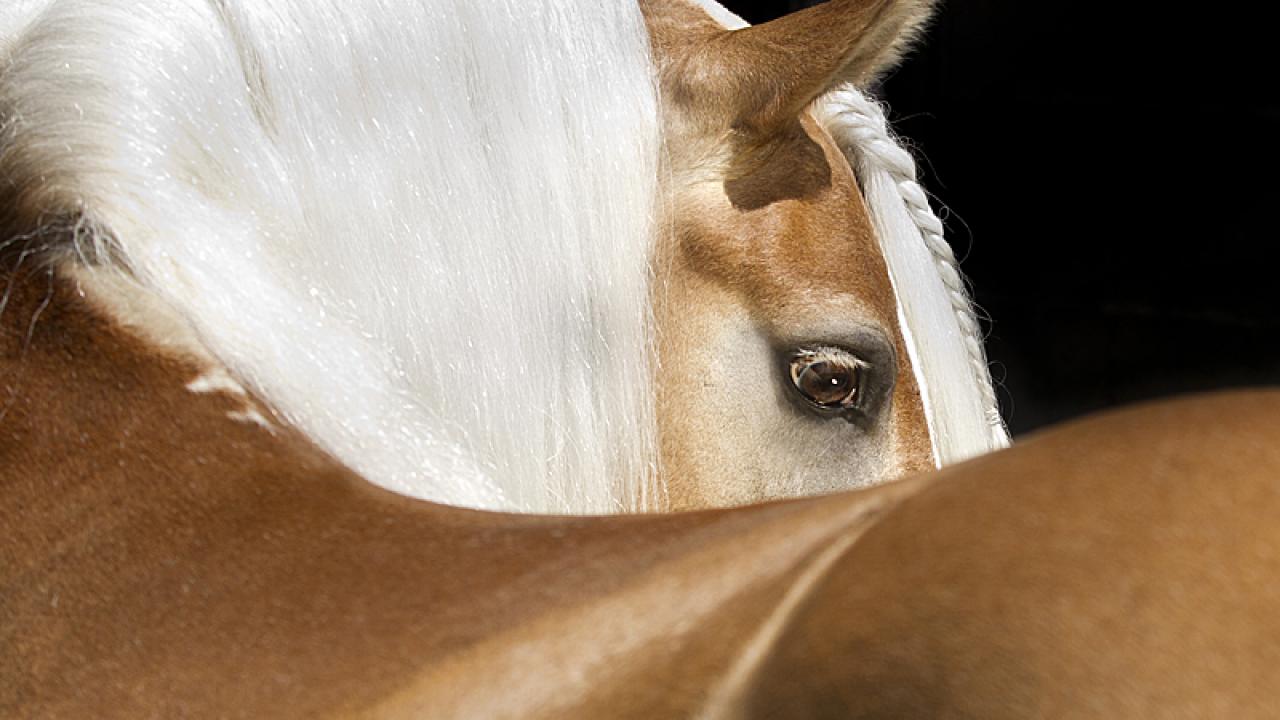
Recent Study Provides Evidence of Causal Role for Eye Cancer Risk Factor in Horses
“Cancer arises from a complex landscape of genetic alternations; pinpointing the driving mutations is like finding a needle in a haystack, but is key to clinical diagnosis and management. Building upon the previous detective work by Dr. Bellone and other UC Davis scientists identifying a candidate risk allele for equine eye cancer, the current study provides compelling molecular and cellular rationale for DDB2-T338M as a major cancer driver mutation, providing extra justification and urgency for diagnostic testing of this risk allele. Additionally, this study connects basic molecular observations in test tubes and cultured cells with population genetics and clinical sciences in horses, attesting to the satisfying power of cross-institutional, interdisciplinary, and laser-focused research efforts to solve diseases.”
- Dr. Lu Chen, Stanford Cancer Institute

Background: Squamous cell carcinoma (SCC) is the most common cancer of the equine eye. Previous research at the UC Davis Veterinary Genetics Laboratory identified a variant in the UV damage DNA repair gene Damage-specific DNA Binding Protein 2 (DDB2) that was strongly associated with SCC risk in Haflingers. Subsequent work found that the variant was also associated with SCC risk in Belgian horses. A case study also supported this as a risk factor in Rocky Mountain Horses. Furthermore, mutations in human DDB2 cause Xeroderma Pigmentosa (XP), a human genetic disorder associated with sun sensitivity and heightened risk for skin cancers.
VGL Director Dr. Bellone and her research team predicted that the variant, a missense mutation that changes the 338th amino acid of the gene’s protein product from threonine to methionine, would produce a misshapen protein that would be unable to detect and repair DNA damaged by sunlight.
The research: Veterinary Genetics Laboratory researchers and collaborators including Dr. Lu Chen from Stanford University, with support from the Center for Equine Health at UC Davis, seek to understand the molecular and cellular consequences of this horse risk allele. The team investigated the mutant protein’s ability to recognize and bind to UV-damaged DNA in the test tube as well as in cultured cells. Known DDB2 mutations in human XP patients were studied in parallel for benchmarking.
The results: A cross-species comparison of the amino acid sequence of the protein and its 3D structure revealed that the position of the mutation is a crucial DNA anchor point. Using recombinant protein technologies, replacement of the normal threonine with methionine at position 338 hindered the protein's ability to bind to synthetic naked DNA in test tubes, and to protein-coated cellular DNA (chromatin). Such DNA-binding defect of the mutant protein also manifested in its inability to be recruited to UV-damaged DNA sites inside of cells, a defect that is shared by other human XP mutants.
This is the first study to investigate the functional consequence of the horse DDB2 c.1013C>T variant. This study provides evidence that the resulting protein is what is increasing risk for ocular SCC in horses with two copies of this variant (denoted by VGL testing as R/R). The mutated protein cannot bind DNA, and thus damage to DNA from the sun cannot be repaired. The accumulation of DNA damage leads to cancer.
These results offer further support of the use of genetic testing to identify those horses at highest risk and to assist in managing and breeding decisions.
For more on this study see: https://www.sciencedirect.com/science/article/pii/S1568786420302822
Funding and acknowledgments:
This work was supported by
- National Institutes of Health
- Stanford Cancer Institute Fellowship
- The UC Davis Center for Equine Health with funds provided by the State of California Pari-Mutuel Fund and contributions by private donors
References:
Lassaline, M., Cranford, T. L., Latimer, C. A., & Bellone, R. (2015). Limbal squamous cell carcinoma in Haflinger horses. Veterinary Ophthalmology, 18(5), 404-408. doi: 10.1111/vop.12229
Bellone, R. R., Liu, J., Petersen, J. L., Mack, M., Singer-Berk, M., Drögemüller, C., Malvick, J., Wallner, B., Brem, G., Penedo, M. C., & Lassaline, M. (2017). A Missense Mutation in Damage-specific DNA Binding Protein 2 Is a Genetic Risk Factor for Limbal Squamous Cell Carcinoma in Horses. International Journal of Cancer, 141(2), 342-353. doi: 10.1002/ijc.30744
Singer‐Berk, M., Knickelbein, K. E., Vig, S., Liu, J., Bentley, E., Nunnery, C., Reilly, C., Dwyer, A., Drögemüller, C., Unger, L., Gerber, V., Lassaline, M., & Bellone, R.R. (2018). Genetic risk for squamous cell carcinoma of the nictitating membrane parallels that of the limbus in Haflinger horses. Animal Genetics, 49(5), 457-460. doi: 10.1111/age.12695
Knickelbein, K. E., Lassaline, M. E., & Bellone, R. R. (2018). Limbal squamous cell carcinoma in a Rocky Mountain Horse: Case report and investigation of genetic contribution. Veterinary Ophthalmology, 22(2), 1–5. doi: 10.1111/vop.12612
Knickelbein, K. E., Lassaline, M. E., Singer‐Berk, M., Reilly, C. M., Clode, A. B., Famula, T. R., Michau T.M., & Bellone, R. R. (2019). A missense mutation in damage‐specific DNA binding protein 2 is a genetic risk factor for ocular squamous cell carcinoma in Belgian horses. Equine Veterinary Journal, 52(1), 34-40. doi: 10.1111/evj.13116
Chen, L., Bellone, R.R., Wang, Y., Singer-Berk, M., Sugasawa, K., Ford, J.M., & Artandi, S.E. (2020). A novel DDB2 mutation causes defective recognition of UV-induced DNA damages and prevalent equine squamous cell carcinoma. DNA Repair, 97. doi: 10.1016/j.dnarep.2020.103022
